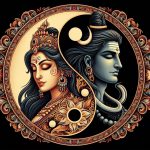Self-reflection is key to unlocking new life. We have discussed in our earlier articles the temperament of individuals matters in the type of method used for spirituality. You can take your time and read our Articles in the Yoga, Meditation, and Mysticism Archive. The temperament of an individual is the first and foremost thing that a Guru must see in his/her student for Tantra Yoga. If you have a teacher, kindly request him/her to help you with identification.
Identification of temperament comes with balanced knowledge.
Identity is one of the parts of Prakriti, i.e. your own primordial nature which is your likes, dislikes, etc. It is as per the Samkhya Yoga. This primordial nature is called Aham and the way you present this nature to the world is called Ahamkara. Crossing the limits of Ahamkara is the final destination to reach Purusha. This Ahamkara has been developed in you since your birth. This is mostly formed because of the knowledge which you have acquired. Again, this knowledge helps you in getting your identity in society. We are identified in society because we present ourselves through the knowledge acquired since birth.

Here the main reason for Ahamkara is the Bondage of Knowledge.
We identify objects because we have learned to do that. People identify us because we present ourselves through what we have learned so far from people, society, parents, teachers, etc. We do things in society with our identity because of knowledge.
The bondage of Knowledge is mentioned as Jnanam Bandha in the Shiva Sutras.
Further, the same book has another statement like Jnanam Annam. This means knowledge is the food. This implies that knowledge when less or excess is dangerous just like food. Lesser knowledge makes people ignorant and more than required knowledge makes a person overqualified. A person with more knowledge remains more theoretical rather than practical. It is certain that both conditions are bondage. Required knowledge when taken perfectly in a balanced condition, acts as food.
If you have a balance between your knowledge and societal life you can identify your temperament. This temperament is the base of Tantra Yoga.
Table of Contents
Knowledge of discrimination and Tantra Yoga.
The knowledge of discrimination is needed in order to identify what is Purusha and what is Prakriti. Sankhya Yoga gives this knowledge. You can click here to have an introduction to Sankhya.
Reflection in Tantra Yoga.
Abinavagupta in the Tantra Loka has written greatly about reflection. He has tried to create an analogy between the mirror and the self. However, there is some form of practice associated with it. He mentions the practice of reflection (pratibimba) to be pratibimbavāda. He tries to explain the reflection in a philosophical manner.
दर्पणबिम्बे यद्वन्न गरग्रामादि चित्रमविभागि । भाति विभागेनैव च परस्परं दर्पणादपि च ॥
Abhinavagupta
विमलतमपरमभैरवबोधात् तद्वद् विभागशून्यमपि अन्योन्यं च ततोऽपि च विभक्तमाभाति जगदेतत् ॥
A nonliterary sense of this shloka would be. In the mirror, we see the objects around but the dimension of the mirror is small. The reflected vision is not different from the real one, in the same way, it’s all the reflection of the supreme Bhairava. Here, the Bhairava is a metaphor for the source of the real reflection within us.
What is self-reflection?
First of all, self-reflection in the literal sense is our real image formed in us. In the mirror, you see your own image. But is that image real for you? In the dark, the mirror to doesn’t work. Where is the real you?
Whatever you learn comes to your mind and it gets reflected when needed. When you eliminate the perception of all the images within you, there exists a real self. In reality, it is only the self that reflects. In the sky, this self-shines as stars, suns, galaxies, etc. They reflect the light.
In human beings, the reflection is only of knowledge. This knowledge is light. It is neither your senses nor your mind. It is the soul.
The practice of self-reflection gives the first major benefit of Tantra Yoga.
We see our reflection in the mirror, however, the reflection is only the function of light. In the same way, whatever you see goes inside the memories. These memories are also in the form of images. Whatever you feel, it is because you visualize it in the mind at first.
Let’s take an example. In their teenage, people usually believe in the idea of love at first sight. The image of the person to whom we are attracted fits into the memories (manas), so perfectly that you start visualizing him/her everywhere.
There is another technique in Tantra Yoga called Visualisation. This is also one of its epitomes.
Sometimes you might get a strong feeling or desire for something. This strong desire starts with the image only. What is the source of that image? The Source of every image is light itself, right? It is science, isn’t it?
But from where it originates? Some call it soul, some call it Shiva, some call it Krishna and some call it from the point which existed during the time of the Big Bang. In Tantra Yoga, directly this source is called Bindu (Point).
Understanding the source of light is the main thing mentioned in the majority of Tantra Yoga Related texts. Light is the essence and only the pillar of Tantra Yoga.



